AOC i2353Ph - IPS for a nice, low price
by Chris Heinonen on January 30, 2012 12:40 AM ESTCalibration and Results
Of course, once we use ColorEyes Display Pro to calibrate the AOC, we would expect even better results than we got out of the box. As usual, we set a white point target of D65, a gamma of 2.2, minimum black level, and a white level of 200 nits. I then checked the quality of the calibration using the Gretag Macbeth color checker chart. Often you will see display reviews that use the calibration target points to see the quality of the calibration. That gives you a good indicator of how well the software and hardware was able to hit those targets, but unfortunately no idea if only those targets improved, or if other colors were improved as well. Using the Gretag Macbeth swatches, which are designed to mimic common colors in the real world, gives you a better idea of the overall quality of the calibration instead of the quality of those specific targets.
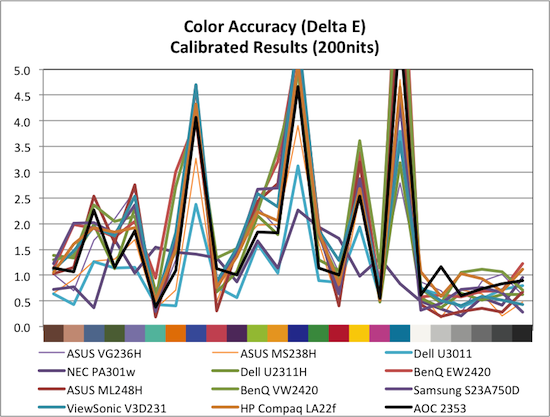
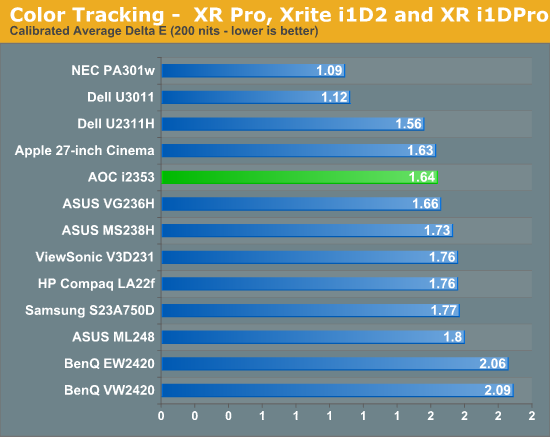
Here we see that the AOC calibrated down to an average dE of 1.64, which is pretty common. When I looked at the results some more, I got a little curious and also decided to see what the median color error was for all the displays. The Gretag Macbeth color checker includes some shades of blue that are at the very edge of the sRGB colorspace, or totally out of it in the case of one sample. In these cases if the display can’t reproduce those shades, the average dE for it might be thrown way off, but the median dE could still be very low since it does a very good job with the colors it can reproduce.
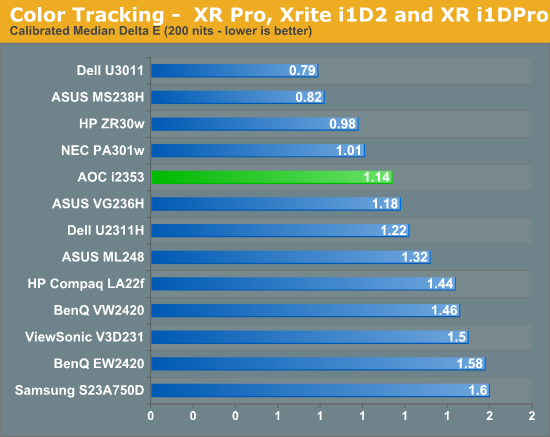
Looking at the results, we can see that the AOC has a much lower median dE than some monitors that produce a lower average dE. When we get to the color gamut data later in the review, we will see that the AOC has a smaller than average gamut, which is leading it to have larger than average errors for color samples on the edge of the sRGB colorspace. In effect, the conclusion we can pull from this is that the AOC can’t produce as many colors as other reviewed displays, but for those that it can produce it does so more accurately. Results like this are why you can’t just look at a lower dE and assume that a display will automatically be better than another display with a higher dE, as it’s just a single number that only tells part of the story.
For people that might use the AOC for press work, or prefer a dimmer display in a dark room like myself, I also calibrated the display to 100 nits of brightness and then took another set of readings.
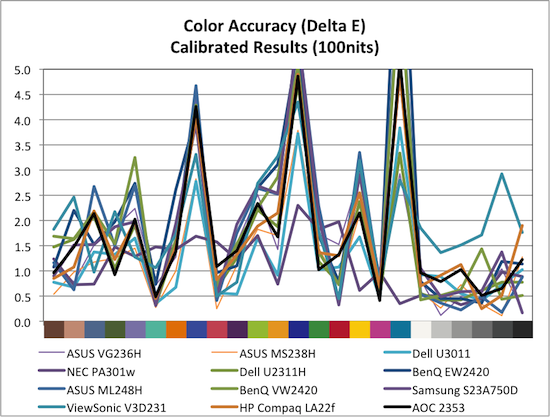
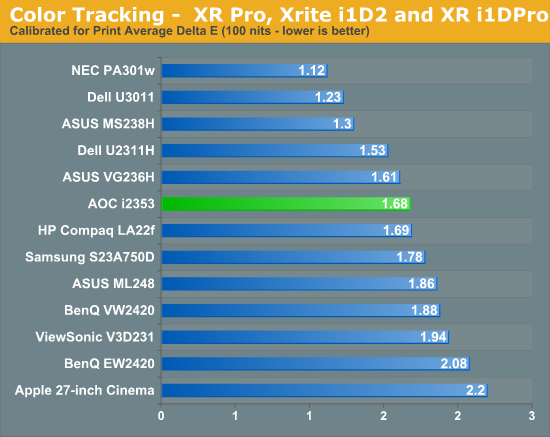
The numbers for 100 nits are almost identical to those for 200 nits. The grayscale is good, and the large errors are all contained in shades of blue, as we would expect.










71 Comments
View All Comments
cashkennedy - Monday, January 30, 2012 - link
Might want to clarify that its too much lag for FPS gaming, as Im pretty sure a latency that small in an RPG or strategy game is not going to have any effect.Jedi2155 - Monday, January 30, 2012 - link
Where did you get the idea that 5ms GTG response time is too much for gaming? The more important consideration IMO is input lag.mathew7 - Monday, January 30, 2012 - link
He said "The lag is a little bit too high for hard core gamers". He measured it at 16ms delay compared to CRT. This is not pixel response that every manufacturer wants and declares it low. Input lag is not specified by manufacturers, and only some reviews (this included) actually measure it.As for categories, FPS is not the only category that benefits from low lag. Racing is another and I'm not talking about the NFS series where a mistake slows you down a bit (in Underground 2 a friend of mine managed to win once by riding each wall in each turn), but where a mistake ends your race (sims).
Samus - Monday, January 30, 2012 - link
Still no reason to replace my $400 Doublesight DS-2700W 27" PVASabresiberian - Monday, January 30, 2012 - link
Umm - who suggested it would be?therealnickdanger - Monday, January 30, 2012 - link
No one, he just wanted to brag.jleach1 - Tuesday, January 31, 2012 - link
Back in the grand turismo days, you used to be able to buy a super car, change the transmission tuning to all acceleration, and the tape the controller stick to ride the wall for Le Mans races.Those were the days... (feeling nostalgic here...not to cheat.)
JonnyDough - Monday, January 30, 2012 - link
I for one, think that 5ms is too slow for gaming. I won't buy a monitor for a gaming system over 3ms, 2 is preferred. Even some movies can show some ghosting at 5ms. I can tell the difference.jleach1 - Tuesday, January 31, 2012 - link
I haven't seen a display with that low of lag. The value of a manufacturers advertised display lag is a joke at best.aguilpa1 - Tuesday, January 31, 2012 - link
I have 3 120Hz Alienware OPTX2310's with rated 3ms refresh rates. It is true that the way manufacture's measure those rates is less then accurate but since it is true of all monitors it is still a good idea if your gaming to get the fastest timings even if it turns out to be more like 5 or 6ms on a 3ms rated overall. You can tell the difference. Also I believe the 2310's even have a better gamma (mid 70's) then this AOC does which is very disappointing for an IPS panel.